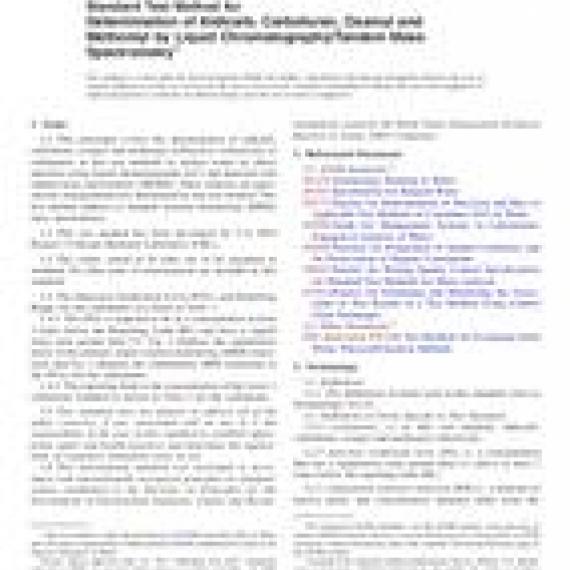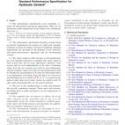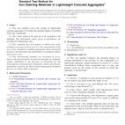No products
ASTM D7600-16(2017)
ASTM D7600-16(2017) Standard Test Method for Determination of Aldicarb, Carbofuran, Oxamyl and Methomyl by Liquid Chromatography/Tandem Mass Spectrometry
standard by ASTM International, 06/15/2017
Full Description
1.1This procedure covers the determination of aldicarb, carbofuran, oxamyl and methomyl (referred to collectively as carbamates in this test method) in surface water by direct injection using liquid chromatography (LC) and detected with tandem mass spectrometry (MS/MS). These analytes are qualitatively and quantitatively determined by this test method. This test method adheres to multiple reaction monitoring (MRM) mass spectrometry.
1.2This test method has been developed by U.S. EPA Region 5 Chicago Regional Laboratory (CRL).
1.3The values stated in SI units are to be regarded as standard. No other units of measurement are included in this standard.
1.4The Detection Verification Level (DVL) and Reporting Range for the carbamates are listed in Table 1.
| Analyte | DVL (ng/L) | Reporting Range (g/L) |
| Aldicarb | 100 | 1-100 |
| Carbofuran | 100 | 1-100 |
| Oxamyl | 100 | 1-100 |
| Methomyl | 100 | 1-100 |
1.4.1The DVL is required to be at a concentration at least 3 times below the Reporting Limit (RL) and have a signal/noise ratio greater than 3:1. Fig. 1 displays the signal/noise ratios of the primary single reaction monitoring (SRM) transitions and Fig. 2 displays the confirmatory SRM transitions at the DVLs for the carbamates.
FIG. 1Example Primary SRM Chromatograms Signal/Noise Ratios


FIG. 2Example Confirmatory SRM Chromatograms Signal/Noise Ratios


1.4.2The reporting limit is the concentration of the Level 1 calibration standard as shown in Table 2 for the carbamates.
| Analyte/Surrogate | LV 1 | LV 2 | LV 3 | LV 4 | LV 5 | LV 6 |
| Aldicarb | 1 | 5 | 10 | 25 | 50 | 100 |
| Carbofuran | 1 | 5 | 10 | 25 | 50 | 100 |
| Oxamyl | 1 | 5 | 10 | 25 | 50 | 100 |
| Methomyl | 1 | 5 | 10 | 25 | 50 | 100 |
| BDMC (Surrogate) | 2 | 10 | 20 | 50 | 100 | 200 |
1.5This standard does not purport to address all of the safety concerns, if any, associated with its use. It is the responsibility of the user of this standard to establish appropriate safety and health practices and determine the applicability of regulatory limitations prior to use.
1.6This international standard was developed in accordance with internationally recognized principles on standardization established in the Decision on Principles for the Development of International Standards, Guides and Recommendations issued by the World Trade Organization Technical Barriers to Trade (TBT) Committee.


































